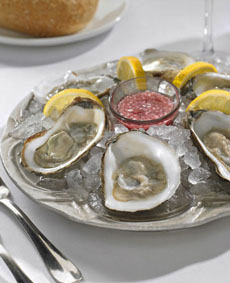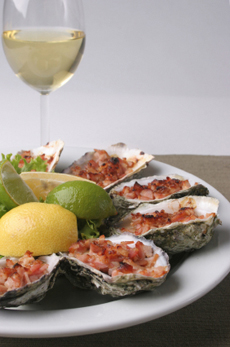FOOD HOLIDAY: National Oyster Day
|
|
It’s National Oyster Day. But hey—aren’t you supposed to avoid oysters in the hot summer months?
Fresh oysters are available year-round, with caveats. The advice not to eat oysters during months spelled without an “r” does not refer to spoilage and food poisoning from eating oysters during June, July and August. Rather, it refers to the oyster’s spawning months, May, June, July and August (in the Northern Hemisphere). The meat from spawning oysters is softer, milkier and more bland than in the fall and winter. When oysters are fattening up, they load up on glycogen, a polysaccharide that is the principal storage form of glucose. This sugar is greatly depleted when oysters spawn, diminishing the quality of their flesh. “If oysters don’t spawn, they grow plump and sweet, and can be harvested year-round,” says Michael Kirkpatrick in his article, ‘Duxbury Pearls: Island Creek Oysters,” in Edible Boston, Spring 2007.’ ” Here’s a tip to enjoy your oysters in the warmer months: Choose oysters from the colder waters of New England and Canada. The oysters don’t spawn, although they grow large as if they were going to. |
|
|
If the oysters don’t spawn, won’t the colony die out? We contacted oyster Kirkpatrick, who advised: “Oyster colonies naturally die out all the time, which is one reason why many, if not most, commercial oyster beds are re-seeded on a regular basis (another reason: to ensure a reliable harvest).” Reseeding involves obtaining oysters from hatcheries and adding them to the beds. Thanks, Michael! If you visit the Cooperstown, New York, area, you can stay at Michael’s bed and breakfast, The Farm. |
||
|
OUR FAVORITE WAYS TO ENJOY OYSTERS The fresher the oysters, the more they demand to be enjoyed absolutely plain. That’s how you taste their terroir and enjoy the undiluted brine in the cups. That’s how we like to eat oysters. If there’s any garnish, it’s a bit of caviar—salmon caviar, tobiko, whitefish, sturgeon or other (the different types of caviar). Need a garnish? Go for a bit of citrus juice (yuzu is the best!) or mignonette sauce: dry white wine, sherry vinegar, chopped shallot and fresh-cracked white pepper. There’s no need to add salt, as oysters have natural salinity. That’s mignonette (min-yo-NET) sauce in the photo at left. The name is French, derived from the word for dainty. Sauces and other toppings were created to spruce up oysters that have lost their spanking freshness. When you top an oyster with cocktail sauce, or with herbed bread crumbs, butter and cream, salt, pepper and hot sauce—Oysters Rockefeller—the oyster flavor is buried under other layers. |
 Oysters with mignonette sauce. Photo courtesy Del Frisco. |
|
|
THE DIFFERENT TYPES OF OYSTERS How many types of oysters have you had? |
||
